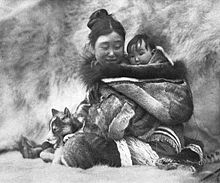Robert J. Flaherty
Robert Joseph Flaherty, FRGS (/ˈflæ.ərti, ˈflɑː-/;[3] February 16, 1884 – July 23, 1951) was an American filmmaker who directed and produced the first commercially successful feature-length documentary film, Nanook of the North (1922).With the aim of showing traditional Inuit life, he also staged some scenes, including the ending, where Allakariallak (who acts the part of Nanook) and his screen family are supposedly at risk of dying if they could not find or build shelter quickly enough.Before the release of Moana, Flaherty made two short films in New York City with private backing, The Pottery Maker (1925) and The Twenty-Four Dollar Island (1927).However, this combination proved even more volatile, and while Flaherty did contribute significantly to the story, the finished film, originally released by Paramount Pictures, is essentially Murnau's.[12][13] Flaherty's career in Britain ended when producer Alexander Korda removed him from the production Elephant Boy (1937), re-editing it into a commercial entertainment picture.As with Nanook, Man of Aran showed human beings' efforts to survive under extreme conditions: in this case, an island whose soils were so thin that the inhabitants carried seaweed up from the sea to construct fields for cultivation.Flaherty again cast locals in the various fictionalized roles, and made use of dramatic recreation of anachronistic behaviors: in this case, a sequence showing the hunting of sharks from small boats with harpoons, which the islanders had by then not practiced for several decades.He also staged the film's climactic sequence, in which three men in a small boat strive to row back to shore through perilously high, rock-infested seas.Among the themes raised by Flaherty's footage were the challenge of the erosion of agricultural land and the Dust Bowl (as well as the beginning of effective responses via improved soil conservation practices), mechanization and rural unemployment, and large-scale migration from the Great Plains to California.[15] Also in the early 1950s, Lowell Thomas, an investor and the most prominent promotor of Cinerama, was eager to secure his "good friend" Flaherty's endorsement of this pioneer film technology.But "just as he was to set forth round the world" to shoot Cinerama footage with Waller's camera, he died, which prompted Thomas to find and hire a new film crew and also join forces with Mike Todd.A self-proclaimed explorer, Flaherty was inducted into the Royal Geographic Society of England for his (re)discovery of the main island of the Belcher group in Hudson Bay in 1914.[17] The Flaherty Seminar is an annual international forum for independent filmmakers and film-lovers, held in rural upstate New York at Colgate University in mid June.[20] The film's title derives from Flaherty's statement that he had been accused, in the staged climactic sequence of Man of Aran, of "trying to drown a boatload of wild Irishmen".In 1994, Flaherty was portrayed by Charles Dance in the Canadian drama film Kabloonak, a dramatization of the making of Nanook of the North from an Inuit perspective.


Iron Mountain, MichiganDummerston, VermontFrances Johnson HubbardMonica Flaherty FrassettoAnthropology of artColor symbolismVisual cultureBody cultureMaterial cultureNew mediaArt of the AmericasIndigenous Australian artOceanic artNanook of the NorthThe Ax FightNǃai, the Story of a ǃKung WomanIncidents of Travel in Chichen ItzaThe Doon School QuintetNational Anthropological ArchivesCentro Cultural MexiquenseMuseum of Anthropology at UBCMuseum of Anthropology, CambridgeMuseum of Indian Arts and CultureRobert Hull Fleming MuseumList of museumsEthnographic filmVideo ethnographyEthnocinemaList of ethnographic filmsMargaret Mead Film FestivalCantometricsMuseum anthropologySalvage ethnographyTribal artFolk artTim AschGregory BatesonFranz BoasPierre BourdieuJohn CollierFrances DensmoreRobert GardnerAlfred GellRobert Hugh LaytonClaude Lévi-StraussAlan LomaxJohn MarshallMargaret MeadAlan MerriamBruno NettlHortense PowdermakerJean RouchDavid MacDougallSocialcultural anthropologyPort Harrisondocumentary filmSouth SeasMan of AranAran IslandsFrances H. FlahertyAcademy AwardLouisiana Storyprospectorstill-photographerTorontoFrances HubbardBryn Mawr CollegePennsylvaniaSuffragette SocietydirectorMini Aodla FreemanHudson Bayiron oreBelcher IslandsSir William MackenzieBell and HowellRevillon FrèresQuebecMelanie McGrathNorthern QuebecInuit who were relocatedResoluteGrise FiordParamountSafuneSavai'idaily rushesritual of a boy's entry to manhoodJohn GriersonThe Pottery MakerIrving ThalbergMetro-Goldwyn-MayerWhite Shadows in the South SeasW. S. Van DykeFox Film CorporationF. W. MurnauParamount PicturesDenis JohnstonAlexander KordaElephant BoyMichael BalconPare LorentzDust BowlU.S. Department of AgricultureHelen van Dongenattack on Pearl HarborMuseum of Modern ArtRichard Leacockoil rigLouisianaStandard OilVirgil ThomsonAcademy Award for Best Documentary FeatureFredric MarchLowell ThomasCineramaFred WallerMike ToddRoyal Geographic SocietyFlaherty IslandColgate UniversityBritish Universities Film & Video CouncilFOCAL InternationalBrian WinstonUniversity of Lincoln